
ROBERT C. STERN, illustrated by DON GREER and RON VOLSTAD
SS ARMOR. A Pictorial History of the Armored Formations of the Waffen-SS
Spring has arrived and suprisingly well equipped trooper of Prinz Eugen poses in front of one of the division's Hotchkiss tanks. Of interest is the Bergmutze which was to be the pattern for the later standard Feldmütze, and the divisional insignia, the so-called "Odalrune", replacing the normal SS right collar tab. [National Archives]

Two views of Prinz Eugen vehicles, dating from Spring and early Summer 1943. Many of the division's original complement of vehicles carried a Yellow Odalrune in a circle insignia, though later replacements most frequently did not.
A Kfz 16 Horch medium signals car, seen here moving cross-country through typically Balkan terrain, carried the divisional marking on its near fender. The pennant on the opposite side indicates that this is a regimental HQ vehicle. [National Archives]

This SdKfz 232 eight wheel radio car of Prinz Eugen seen in June 1943, appears to be virtually free of marking, only a license plate and hull side cross being visible. This is typical of the appearance of this division's vehicles for the remainder of the war. [Scott Van Ness]

The pause that followed the completion of the Manstein Offensive allowed the repair of worn vehicles and the addition of new.
A rare shot of a halftrack workshop, full of both Wehrmacht and SS vehicles in various stages of repair. From the left, the identifiable vehicles are a one ton, a three ton with Sand Yellow overspray with another one ton and an eight ton behind it, a one ton missing its hood in the center and a twelve ton to the right. Of interest is the difference in the pattern of the license plates on the twelve ton. [Bundesarchiv]

This PzKpfw IV ausf F2 of Das Reich has also had its coat of Panzer Grey oversprayed with the newly authorized Sand Yellow. [Bundesarchiv]
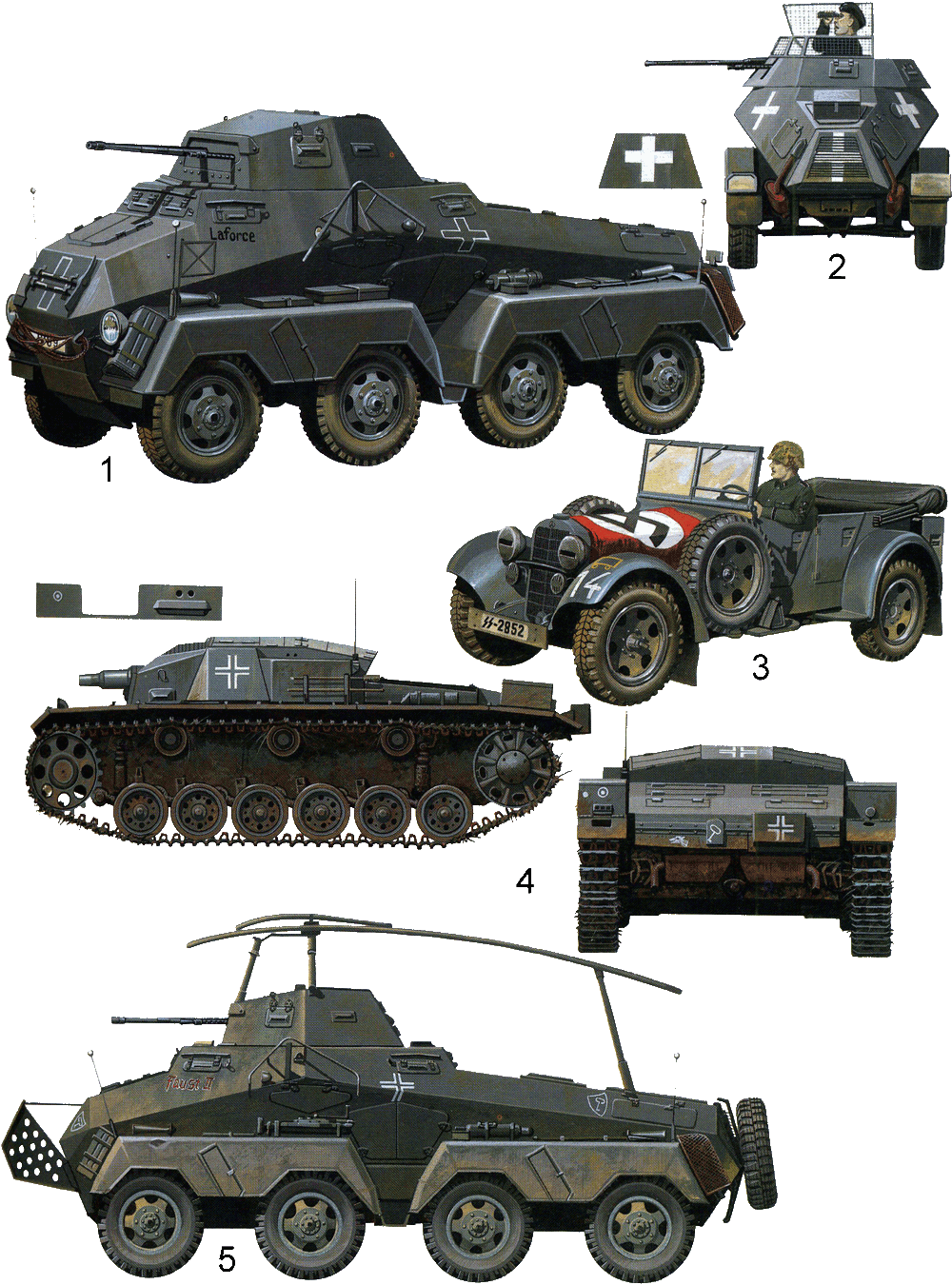
1. "Laforce", SdKfz 231 of LSSAH [mot], October 1939, Prague, Czechoslovakia.
2. SdKfz 222 of LSSAH [mot], September 1939, Poland.
3. Kfz 11 [Mercedes- Benz 230], of SS-V [mot], May 1940, France.
4. StuG III ausf A of LSSAH [mot], August 1940, France.
5. "Faust II", SdKfz 232 of LSSAH [mot], April 1941, Greece.


Two views of the new Tiger ausf Es that were being issued to the heavy tank battalions of the SS divisions. These Tigers of Das Reich are extremely early models, complete with the "S" mine projectors at the corners, early style cupola and Feifel air cleaning system. The tank to the right in the shot below is a PzKpfw III ausf M or N. Many new vehicles at this date were arriving still painted in overall Panzer Grey, these have had their original color oversprayed. In the view to the left, notice that in combination with natural shadow, this camouflage scheme was effective in breaking up the shape of the vehicle. [Bundesarchiv]

A rare vehicle, no more than twenty of these SdKfz 247/1 armored command cars were built, being issued solely to elite units such as the Wehrmacht's Grossdeutschland and LAH. The extremely low license plate number indicates thai this was one of the division's original vehicles. [Bundesarchiv]

The battle of Kursk opened with perhaps the greatest concentration of armor ever assembled for one operation. This line up of late PzKpfw IV ausf Gs of the 7th Company of Leibstandarte's Panzer-Regiment approaches a horizon already smoking from the opening barrages of the battle. These brand new vehicles are painted overall Sand Yellow with an overspray of Red Brown. From this point on, Sand Yellow was to be the standard base coat on all new vehicles and, as time permitted, old equipment was repainted. But, understandably, a great variety in color schemes was evident throughout this Summer. [Scott Van Ness]
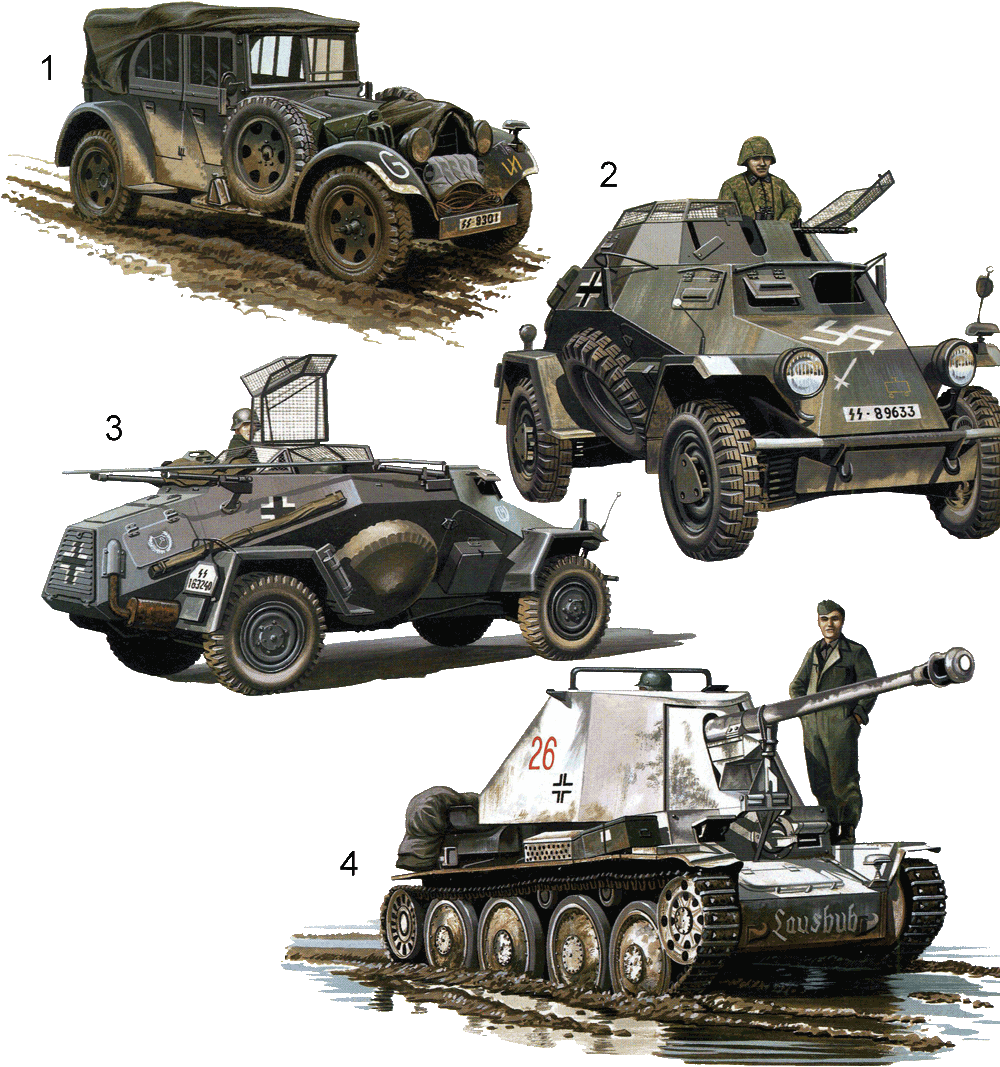
1. Kfz 11 [Mercedes-Benz 230] of SS-Div "Reich", October 1941, Central Russia.
2. SdKfz 222 SS-Kav-Brig, August 1941, North Russia.
3. SdKfz 261 of SS-Pz- Gren-Div "LSSAH", September 1942, Paris, France.
4. "Lousbub", Panzer-jäger 38 [t] Marder III [SdKfz 138] of SS-Pz-Gren-Div "LSSAH", February 1943, Kharkov, Russia.
Decline: Summer 1943 - Summer 1944
The attack that began on 5 July 1943 against the Kursk salient was code named "Zitadelle". The salient that just ten weeks before had been only weakly held now was jammed with enemy troops. 40% of Russian forces, and a full 90% of their armor was concentrated at or behind Kursk. On both fronts of the salient, the Germans had arrayed a force of 19 armored divisions. The attack was to be the greatest, and most wasteful, armored offensive launched by Germany. Very nearly successful, in the longrun was to prove a disaster from which the German armed forces were never to recover.
In the center of Manstein's formations on the southern edge was the SS-Panzer-Korps attacking just west of the Donets toward Oboyan and Kursk. Facing it was the Russian Sixth Guards Army including two complete Guards Tank Corps. Stalin was taking no chances. Yet when the attack came, the SS had success. The Russians were being beaten.
Led by their own Tigers and the Panthers of the hastily assembled Panther Brigade attached to Das Reich, holes were being punched in the Russian lines. Help came from the sky as well, as tank-busting Stukas paved the way for the SS tanks. So rapid was the advance that by noon on 6 July, the Der Fuhrer regiment of Das Reich had taken Luchki I, 20 miles deep into the defenses. From there on resistance stiffened as SS-Panzer-Korps found itself taking on the crack Fifth Guards Tank Army pressing in from the east. 3. Panzer-Korps, East of the Donets, which was to have held this flank open for Das Reich, was disastrously slow in coming into action.
Nevertheless, by 11 July LAH and Das Reich had taken positions on either side of Prokhorovka, another 20 miles into Russian lines. At the same time Totenkopf had forced a crossing of the Psel on the flank of enemy defenses at Oboyan, poised to drive the remaining 40 miles to Kursk. There they sat for six days. Without their flank protected, LAH and Das Reich were forced to remain facing East rather than North, and without the support of the other two divisions, Totenkopf could not move. They were not to move forward from there. On 17 July, when 3. Panzer-Korps had finally recrossed the Donets to fall on the flank of the 6th Guards Tank Army, Hitler lost his nerve. In response to desperate Russian attacks North and South of the salient, and the Allied landings on Sicily, "Zitadelle" was called off and the SS units ordered to Italy.
In actual fact only Leibstandarte was sent to Italy. Before Das Reich and Totenkopf could entrain, a more immediate crisis loomed on the Mius. They were promptly sent South to counter Russian penetrations toward Stalino. Their attacks were successful and by 3 August the Mius line was re-established. No sooner had that problem been solved than their services were once again required to the North. For the third time in a year, Hausser led Das Reich and Totenkopf into Kharkov on 12 August 1943. This time, however, the stay was brief. Hard pressed on both sides of the city, the two divisions soon found their positions untenable and on 22 August they were pulled out of the city for the last time. They then joined the now general retreat on the Dnieper, heading towards Kiev. By early September, Das Reich and Totenkopf were in reserve behind Kiev awaiting developments.
Wiking, because its refit after the rigors of the previous Summer's campaigns had been only partial, had been held in reserve during the fighting at Kursk. When Russian spearheads broke through in the Orel region, Wiking was immediately dispatched in an attempt to seal the penetrations. The division, however, simply did not have the strength to stem the enemy advance. As with the rest of the German forces in Southern Russia, Wiking retreated toward the Dnieper, crossing the river at Gomel. It was then withdrawn to the Balkans for a complete refit.
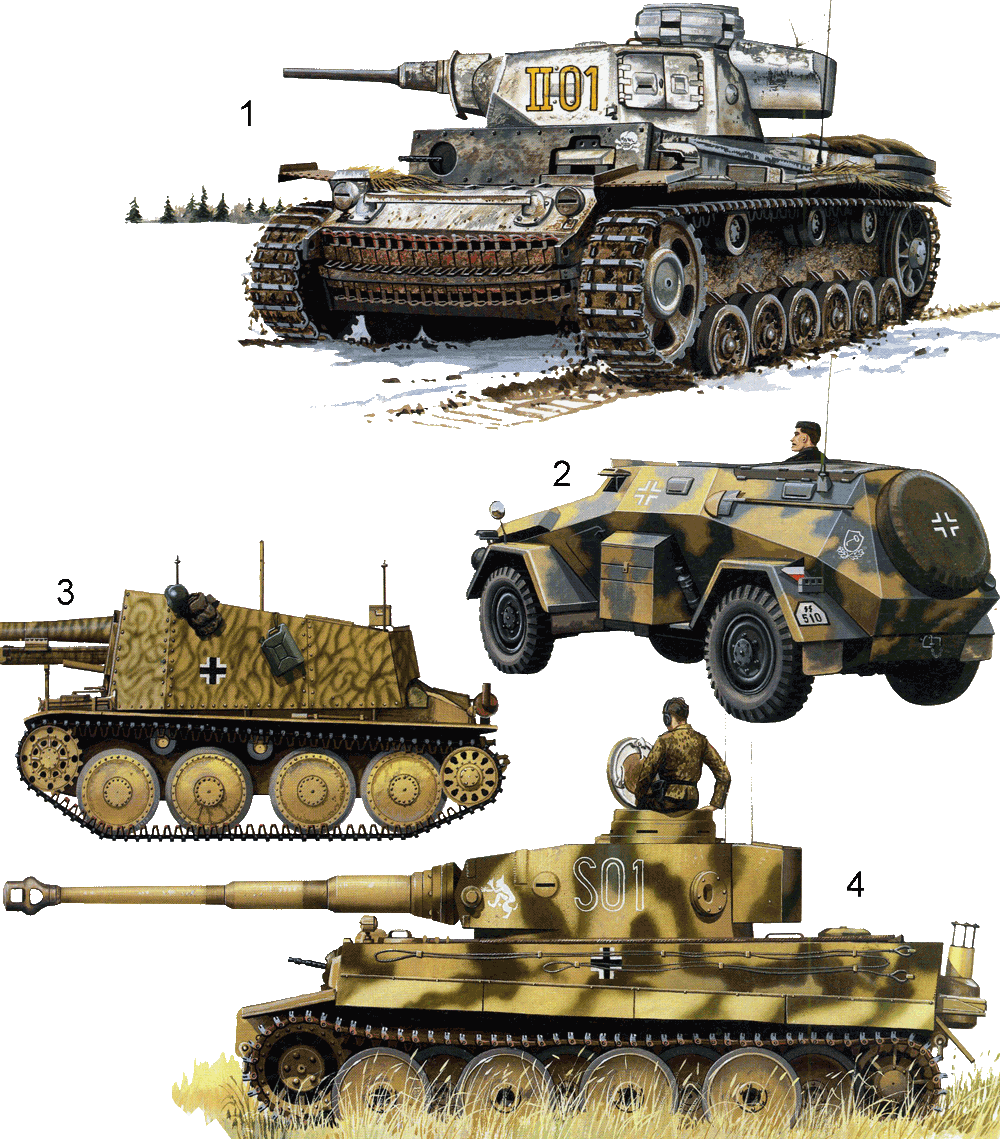
1. PzBefWg III ausf K of SS-Pz-Gren-Div "Totenkopf", March 1943, Central Russia.
2. SdKfz 247 of SS-Pz-Gren-Div "LSSAH", April 1943, Central Russia.
3. SdKfz 138/1 "Bison" of SS-Pz-Gren-Div "Das Reich", July 1943, Kursk, Russia.
4. Tiger I ausf E of SS-Pz-Gren-Div "Das Reich", July 1943, Kursk, Russia.

Two more views of Leibstandarte vehicles during the Kursk Offensive.
The crew of one of 6th Company's Tigers mounts their vehicles prior to returning to the action. The Sand Yellow has been generally oversprayed with Red Brown, while on the superstructure side that second color has been brushed on directly. The flag, used for air recognition, is being flown from the radio antenna. [Scott Van Ness]

A unique shot showing a quiet moment in the midst of battle. Two Russian prisoners, one wounded, are being interrogated by the commanders of one of LAH's panzergrenadier companies. The captain [Hauptsturmführer] is wearing the Black panzer uniform smoking a cigarette, while his assistant, a Scharführer, is bending over the two prisoners removing his glove. The Scharführer carries his rank insignia in the form of two Green stripes on the arm of his camouflage smock. The SdKfz 251 mSPW from which they have dismounted is Panzer Grey broadly oversprayed with Sand Yellow and liberally covered with foliage. The two other 251s visible on the left appear to be overall Sand Yellow. [Scott Van Ness]

Jochen Peiper of LAM, later to become infamous in the West for his deeds during the Ardennes Offensive, gained his reputation for success and for ruthlessness in the battles at Kursk and after. He is wearing a motoring coat and an SS pattern camouflage cap. [Scott Van Ness]

After leaving its entire armored element behind in Russia to be split up among the remaining divisions, Leibstandarte spent its time in Italy training and once again re-equipping. As summer progressed, LAH received a complete new Panzer-Regiment including a Panther-Abteilung, and was at the same time renamed 1. SS-Panzer-Division "Leibstandarte SS Adolf Hitler". When the German forces in the East proved unable to hold the Russians and pulled back to the Dnieper, LAH was once again ordered back, this time to Kiev.
Unfortunately, Kiev would no longer be in German hands when LAH arrived. After taking positions behind the Dnieper in early November 1943, there had been a general redistribution of the SS formations. Das Reich remained near Kiev while Totenkopf was posted South to act in reserve behind the Dnieper front at Dnepropetrovsk. Wiking, upon its return from refit in December, was posted to the relatively quiet sector at Cherkassy. Meanwhile the first of the four new SS armored divisions, Nordland, came into action on the Leningrad front, where it was to see bitter fighting during that Winter's retreats to the Narva.
The end result of this dispersal of SS forces was that when the Russians broke through the Dnieper line north of Kiev in early November 1943, only Das Reich was in position to counterattack. And in a story that was to become all too familiar, it simply was not strong enough to stem the flood of enemy pouring to the South and West. In fact, by 6 November, it had been forced out of Kiev to the Southwest. Only after desperate fighting were the Russian drives to the South blunted and finally halted at Fastov. But even with the arrival of LAH on 12 November, it proved impossible to throw the enemy back over the Dnieper.
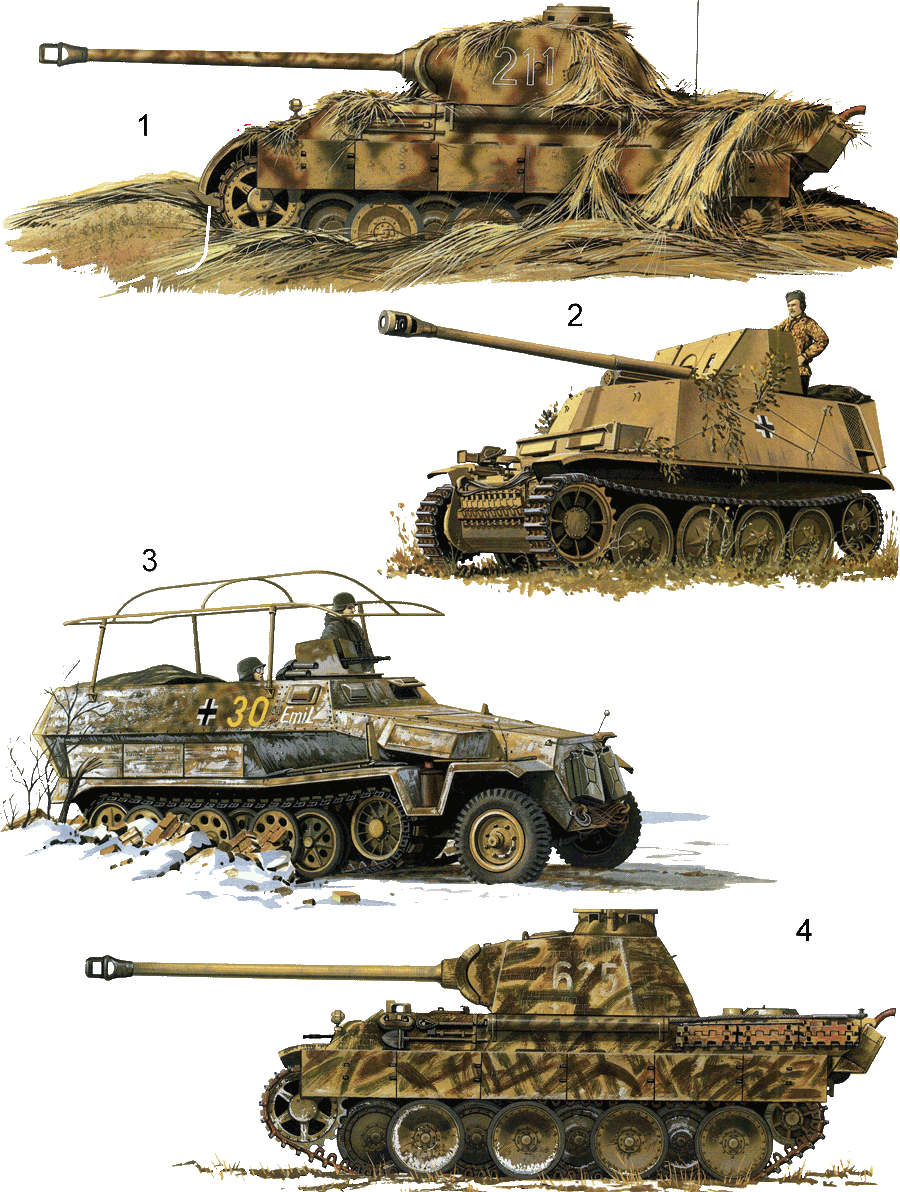
1. Panther ausf D of SS-Panther-Brigade, July 1943, Kursk, Russia.
2. PzJg II ausf D of SS-Pz-Gren-Div "Wiking", Autumn 1943, Central Russia.
3. "Emil", SdKfz 251/3 m. Funkpanzerwagen of 1. SS-Pz-Div "LSSAH", March 1944, Central Russia.
4. Panther ausf A of 5.SS-Pz-Div "Wiking" April 1944, Poland.
This was not for lack of trying. Between 15 November and 30 December, LAH and to a lesser extent the much weakened Das Reich were involved in a series of counterstrokes, as part of Balck's 48. Panzer-Korps, that came close to achieving a major coup. First trapping three Russian Corps at Brusilov, then recapturing Radomyshl and finally attempting to encircle a large enemy force east of Korosten, Leibstandarte desperately tried to re-establish the German defensive lines around Kiev. In the fighting around Korosten the inadequacy of German strength again was shown. LAH, along with 1. and 7. Panzer-Divisions, threw a ring around seven Russian Corps. Not only could the encirclement not be held around so massive a force, but soon the Germans were fighting desperately to keep from being entrapped by their intended victims. By now the Russians had again broken through at Brusilov, overwhelming 24. Panzer-Korps, to which Das Reich had been attached. LAH linking up with the remnants of Das Reich, fought its way back through Zitomir, establishing a line in front of that city. Moved again, this time to Berdichev, LAH and 1. Panzer-Division halted Russian attacks there and by New Year won a well deserved month's rest. By now both sides were too exhausted to continue the fighting in the Ukraine, for a while at least. Das Reich, badly mauled in the fighting at Kiev and Brusilov, had the bulk of its forces pulled back to France in early February 1944. A regiment-sized battle group [K-Gr Lamerding] remained behind with LAH to continue the fight. The next round opened at Cherkassy. Having been halted to the North at Berdichev and to the South at Kirovograd (where Totenkopf had been engaged in bloody fighting alongside Grossdeutschland), the enemy came through the middle. Having been unable to encircle the German 8. and 1. Panzer-Armee, the Russians settled for the two corps that were still holding the Dnieper line between Kanev and Cherkassy. After some of the fiercest fighting yet seen, including a charge by three Russian Cavalry Divisions, the enemy broke through on 1 February to the North and South of the German salient, trapping six divisions, including Wiking, in a large pocket around Korsun.
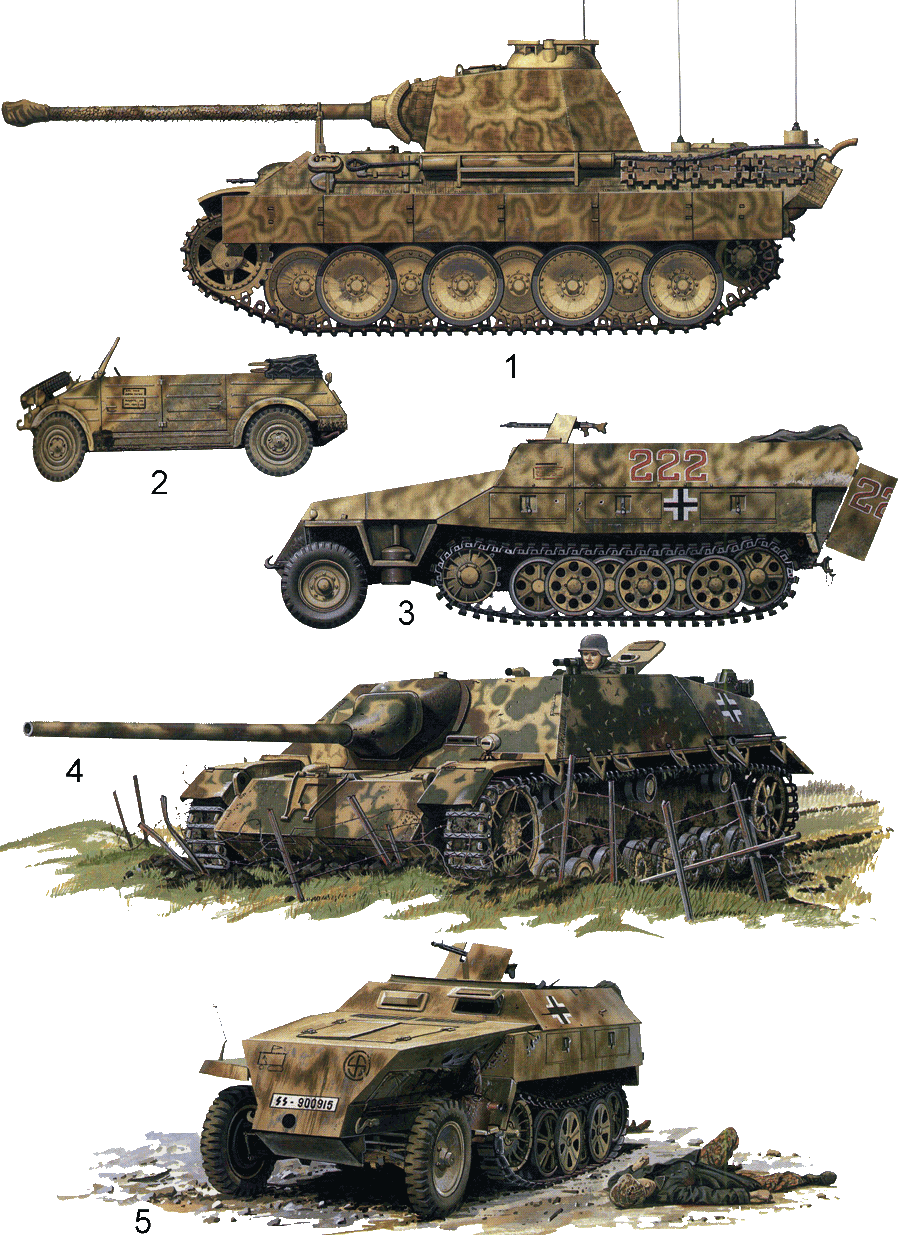
1. Panther ausf G of 1.SS-Pz-Div "LSSAH", May 1944, Paris, France.
2. Kfz 1 [VW Kubelwagen] of 12.SS-Pz- Div "Hitlerjugend", June 1944, Normandy, France.
3. SdKfz 251/1 of 5.SS-Pz-Div "Wiking", August 1944, Warsaw, Poland.
4. Panzer IV/70 of 12.SS-Pz-Div "Hitlerjugend", December 1944, Ardennes, Belgium.
5. SdKfz 250/1 of 11. SS-Freiwilligen-Pz-Gren-Div "Nordland", May 1945, Berlin, Germany.


Two views of a convoy of armored vehicles of Das Reich on a dusty road behind the Kursk front. The 15cm sIG Bison seen above is Sand Yellow with a complex overspray of Olive Green. At the left is an SdKfz 251/1 mSPW carrying a member of the division's Feldgendarmerie [Military Police]. He can be seen leaning on the edge of the APC's fighting compartment, holding his Red and White traffic control paddle. [Bundesarchiv]

On their way to the front, a Kfz 1/20 VW type 166 Schwimmwagen and a Ford V-3000 three ton truck of Das Reich pass a Kfz 1 IPKW of the Luftwaffe. Both Das Reich vehicles carry the temporary divisional insignia adopted immediately before the Kursk Offensive to confuse enemy intelligence. The Schwimmwagen bears the markings ol the division's Panzer-Regiment. [Bundesarchiv]

An interesting shot showing three mechanics working on the engine of a Das Reich SdKfz 231 eight wheel armored car. The spare tire obviously was missing before the vehicle was repainted Sand Yellow. Of interest is the plate upon which the divisional insignia has been painted. It was partly masked off during repainting, showing to good advantage the apparent difference in tone between Panzer Grey and Sand Yellow. [Bundesarchiv]

This Obersturmfährer, probably a zug [troop] commander, sits perched confidently on his tank's cupola. He is wearing the rarely seen tanker's one-piece camouflage suit. [Scott Van Ness]

A mixed company of Das Reich tanks advances against the Russians. The two vehicles in the center background are late model PzKpfw Ills, the rest being PzKpfw IV ausf Gs. All the Gs have turret schurzen, the nearest one is unusual in having side skirts as well. [Scott Van Ness]
The story of the previous year's fighting in the East had been one of just such encirclements and their attempted relief. Since the disaster at Stalingrad, the Germans had been successful each time in relieving surrounded troops and expected to be so again. On the basis of this expectation, the six divisions were told to hold their ground and await developments. But this was the largest such encirclement since Stalingrad and the Russians were determined that the same fate should befall these men as befell 6. Armee just a year before. The Germans brought up a relief force of four Panzer Divisions led by 1. Panzer-Division and LAH. It was to be strength against strength. Arriving in the area of Buzhanka on 3 February, LAH was launched immediately at the enemy-held neck of land separating the relief force from the encircled troops, specifically at the village of Shenderovka. In part because of gross miscalculation on the part of the German High Command (OKH), which caused the main attack to be misdirected for several days, and in part because four tired Panzer Divisions were simply not strong enough to break a line held in depth by two Tank and one Guards Tank Army, the attack failed. After twelve days of bitter Winter fighting the relief forces had penetrated no more than halfway through the 20 miles that separated them from the encircled divisions.
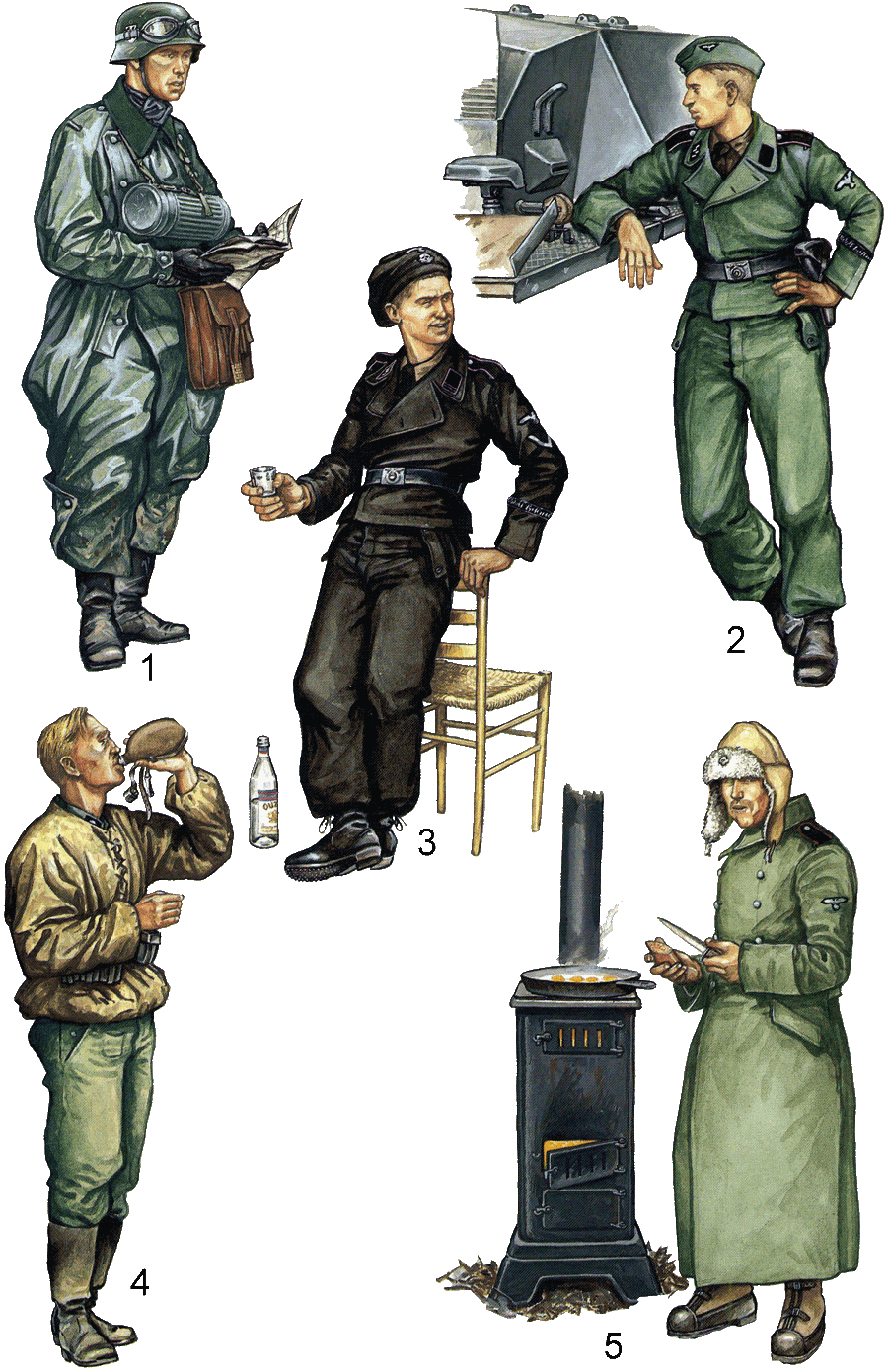
1. Motorcyclist, SS-V Division, France, Spring 1940. He is wearing the Motorcyclist's Waterproof Coat.
2. SS-Mann, Assault Gunn Loader, Leibstandarte SS "Adolf Hitler" (mot), France, Summer 1940. He is wearing the Field Grey version of the Special Panzer Uniform. His shoulder straps are piped with the Pink waffenfarbe of armored troops.
3. SS-Sturmmann, Armored Car Gunner, Leibstandarte SS "Adolf Hitler" (mot), Greece, Spring 1941. He wears the Special Panzer Uniform. Note the Brown shirt and Black tie, characteristic of SS armored units early in the war.
4. Motorcycle Assault Trooper. SS-Totenkopf-Division, Russia, Summer 1941. He is dressed in a standard SS Camouflage Smock which has faded to the point that the pattern has almost disappeared.
5. Munitions Handler, SS-Panzer-Division "Totenkopf", Russia, Winter 1942. He wears the standard mid-war overcoat with felt and leather Snow Boots and fur cap.
We have much more interesting information on this site.
Click MENU to check it out!
∎ cartalana.com© 2009-2025 ∎ mailto: cartalana@cartalana.com